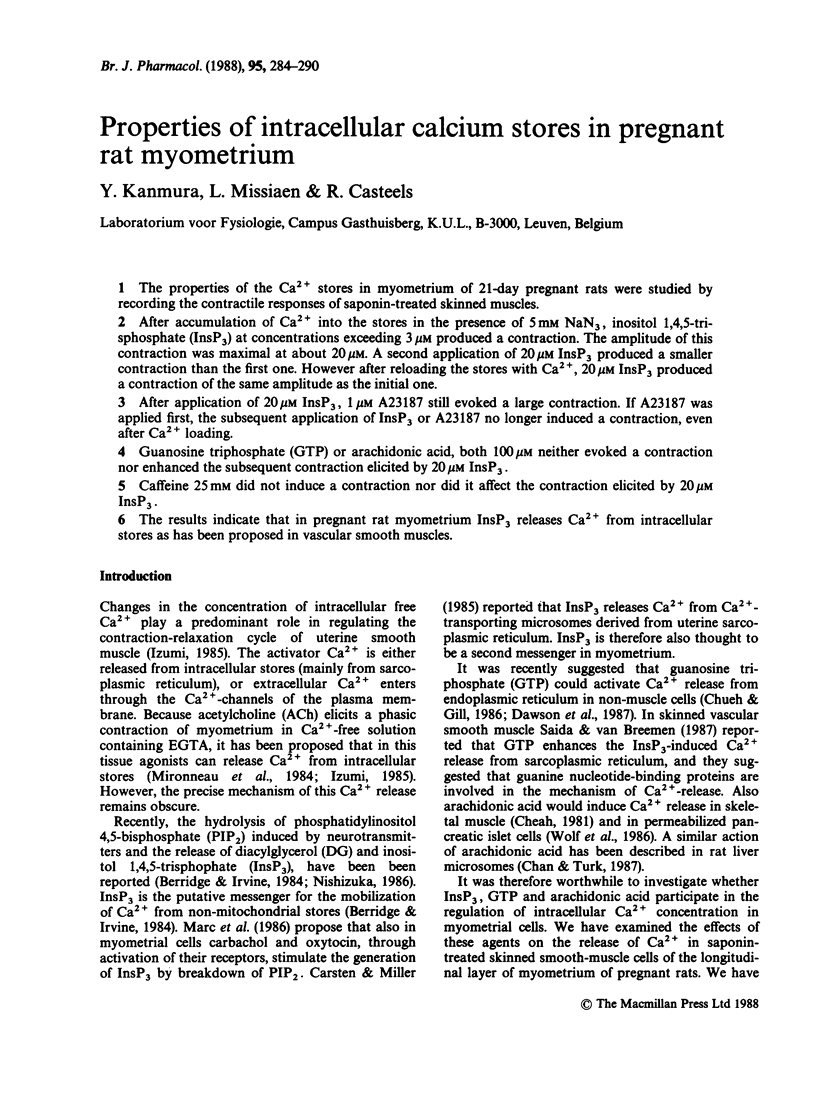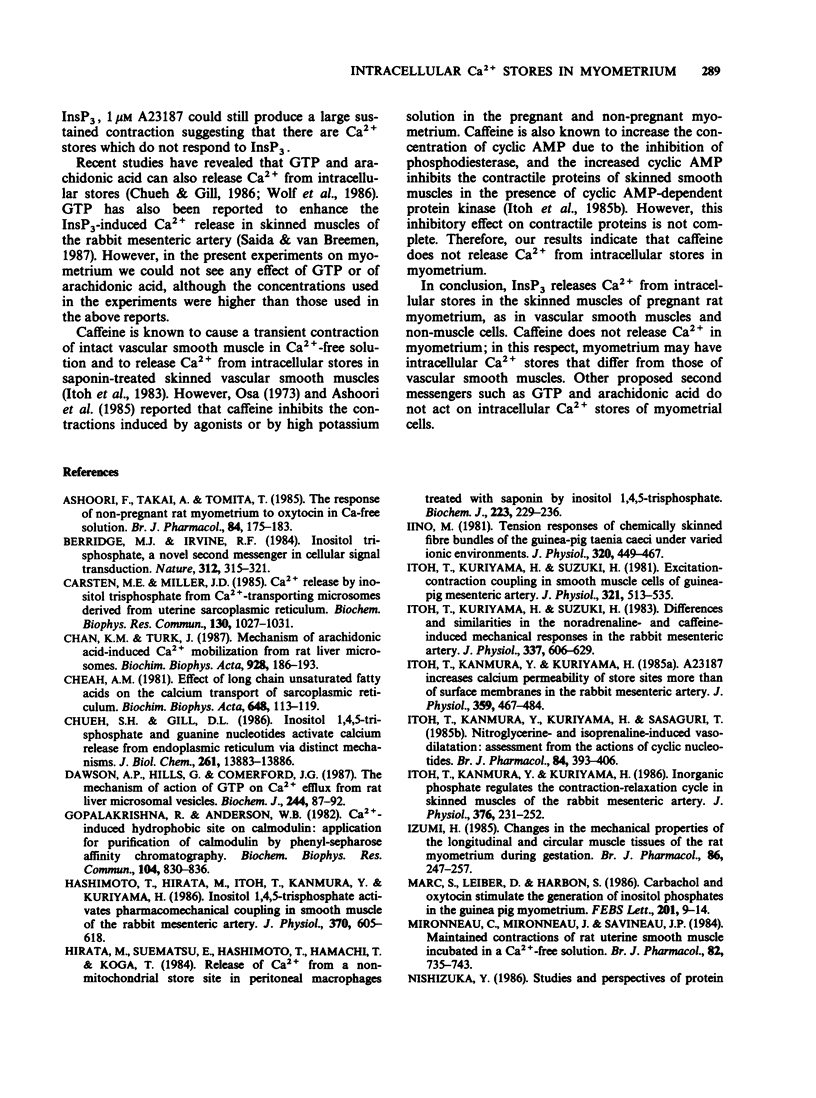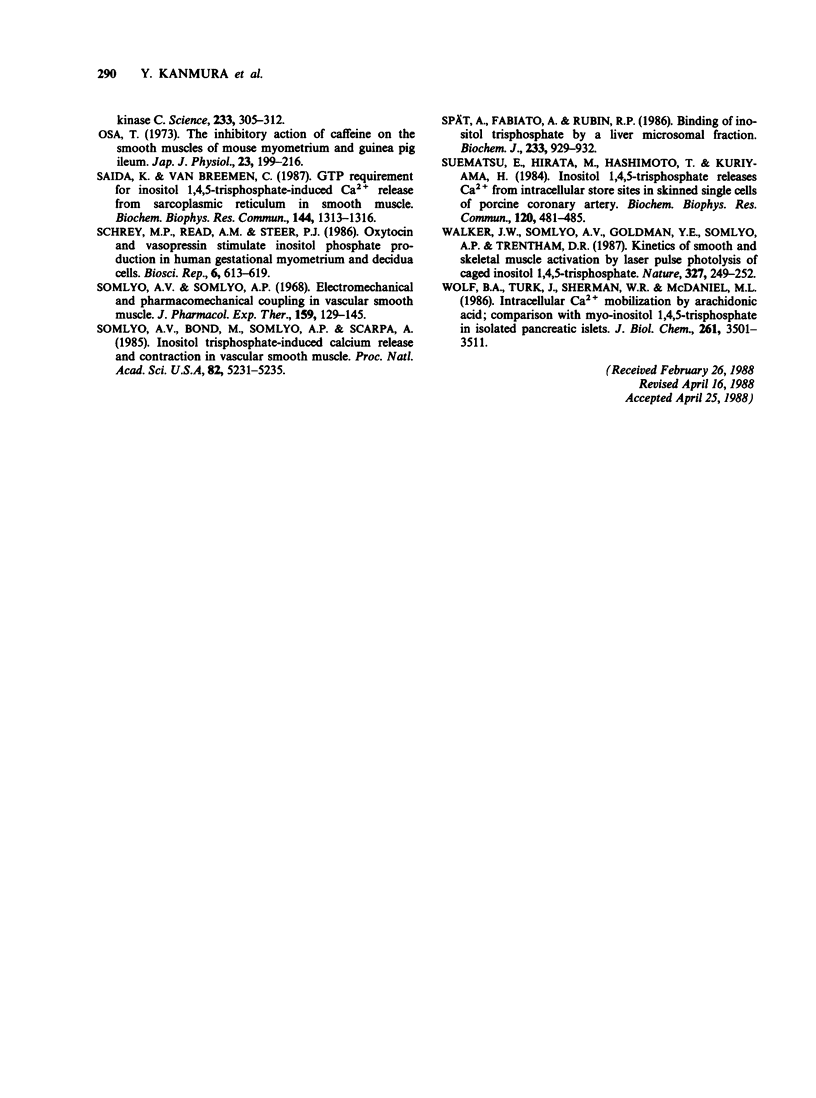Abstract
1. The properties of the Ca2+ stores in myometrium of 21-day pregnant rats were studied by recording the contractile responses of saponin-treated skinned muscles. 2. After accumulation of Ca2+ into the stores in the presence of 5 mM NaN3, inositol 1,4,5-trisphosphate (InsP3) at concentrations exceeding 3 microM produced a contraction. The amplitude of this contraction was maximal at about 20 microM. A second application of 20 microM InsP3 produced a smaller contraction than the first one. However after reloading the stores with Ca2+, 20 microM InsP3 produced a contraction of the same amplitude as the initial one. 3. After application of 20 microM InsP3, 1 microM A23187 still evoked a large contraction. If A23187 was applied first, the subsequent application of InsP3 or A23187 no longer induced a contraction, even after Ca2+ loading. 4. Guanosine triphosphate (GTP) or arachidonic acid, both 100 microM neither evoked a contraction nor enhanced the subsequent contraction elicited by 20 microM InsP3. 5. Caffeine 25 mM did not induce a contraction nor did it affect the contraction elicited by 20 microM InsP3. 6. The results indicate that in pregnant rat myometrium InsP3 releases Ca2+ from intracellular stores as has been proposed in vascular smooth muscles.
Full text
PDF






Selected References
These references are in PubMed. This may not be the complete list of references from this article.
- Ashoori F., Takai A., Tomita T. The response of non-pregnant rat myometrium to oxytocin in Ca-free solution. Br J Pharmacol. 1985 Jan;84(1):175–183. [PMC free article] [PubMed] [Google Scholar]
- Berridge M. J., Irvine R. F. Inositol trisphosphate, a novel second messenger in cellular signal transduction. Nature. 1984 Nov 22;312(5992):315–321. doi: 10.1038/312315a0. [DOI] [PubMed] [Google Scholar]
- Carsten M. E., Miller J. D. Ca2+ release by inositol trisphosphate from Ca2+-transporting microsomes derived from uterine sarcoplasmic reticulum. Biochem Biophys Res Commun. 1985 Aug 15;130(3):1027–1031. doi: 10.1016/0006-291x(85)91718-8. [DOI] [PubMed] [Google Scholar]
- Chan K. M., Turk J. Mechanism of arachidonic acid-induced Ca2+ mobilization from rat liver microsomes. Biochim Biophys Acta. 1987 Apr 22;928(2):186–193. doi: 10.1016/0167-4889(87)90120-0. [DOI] [PubMed] [Google Scholar]
- Cheah A. M. Effect of long chain unsaturated fatty acids on the calcium transport of sarcoplasmic reticulum. Biochim Biophys Acta. 1981 Nov 6;648(2):113–119. doi: 10.1016/0005-2736(81)90025-0. [DOI] [PubMed] [Google Scholar]
- Chueh S. H., Gill D. L. Inositol 1,4,5-trisphosphate and guanine nucleotides activate calcium release from endoplasmic reticulum via distinct mechanisms. J Biol Chem. 1986 Oct 25;261(30):13883–13886. [PubMed] [Google Scholar]
- Dawson A. P., Hills G., Comerford J. G. The mechanism of action of GTP on Ca2+ efflux from rat liver microsomal vesicles. Biochem J. 1987 May 15;244(1):87–92. doi: 10.1042/bj2440087. [DOI] [PMC free article] [PubMed] [Google Scholar]
- Gopalakrishna R., Anderson W. B. Ca2+-induced hydrophobic site on calmodulin: application for purification of calmodulin by phenyl-Sepharose affinity chromatography. Biochem Biophys Res Commun. 1982 Jan 29;104(2):830–836. doi: 10.1016/0006-291x(82)90712-4. [DOI] [PubMed] [Google Scholar]
- Hashimoto T., Hirata M., Itoh T., Kanmura Y., Kuriyama H. Inositol 1,4,5-trisphosphate activates pharmacomechanical coupling in smooth muscle of the rabbit mesenteric artery. J Physiol. 1986 Jan;370:605–618. doi: 10.1113/jphysiol.1986.sp015953. [DOI] [PMC free article] [PubMed] [Google Scholar]
- Hirata M., Suematsu E., Hashimoto T., Hamachi T., Koga T. Release of Ca2+ from a non-mitochondrial store site in peritoneal macrophages treated with saponin by inositol 1,4,5-trisphosphate. Biochem J. 1984 Oct 1;223(1):229–236. doi: 10.1042/bj2230229. [DOI] [PMC free article] [PubMed] [Google Scholar]
- Iino M. Tension responses of chemically skinned fibre bundles of the guinea-pig taenia caeci under varied ionic environments. J Physiol. 1981 Nov;320:449–467. doi: 10.1113/jphysiol.1981.sp013961. [DOI] [PMC free article] [PubMed] [Google Scholar]
- Itoh T., Kanmura Y., Kuriyama H. A23187 increases calcium permeability of store sites more than of surface membranes in the rabbit mesenteric artery. J Physiol. 1985 Feb;359:467–484. doi: 10.1113/jphysiol.1985.sp015597. [DOI] [PMC free article] [PubMed] [Google Scholar]
- Itoh T., Kanmura Y., Kuriyama H. Inorganic phosphate regulates the contraction-relaxation cycle in skinned muscles of the rabbit mesenteric artery. J Physiol. 1986 Jul;376:231–252. doi: 10.1113/jphysiol.1986.sp016151. [DOI] [PMC free article] [PubMed] [Google Scholar]
- Itoh T., Kanmura Y., Kuriyama H., Sasaguri T. Nitroglycerine- and isoprenaline-induced vasodilatation: assessment from the actions of cyclic nucleotides. Br J Pharmacol. 1985 Feb;84(2):393–406. doi: 10.1111/j.1476-5381.1985.tb12923.x. [DOI] [PMC free article] [PubMed] [Google Scholar]
- Itoh T., Kuriyama H., Suzuki H. Differences and similarities in the noradrenaline- and caffeine-induced mechanical responses in the rabbit mesenteric artery. J Physiol. 1983 Apr;337:609–629. doi: 10.1113/jphysiol.1983.sp014645. [DOI] [PMC free article] [PubMed] [Google Scholar]
- Itoh T., Kuriyama H., Suzuki H. Excitation--contraction coupling in smooth muscle cells of the guinea-pig mesenteric artery. J Physiol. 1981 Dec;321:513–535. doi: 10.1113/jphysiol.1981.sp014000. [DOI] [PMC free article] [PubMed] [Google Scholar]
- Izumi H. Changes in the mechanical properties of the longitudinal and circular muscle tissues of the rat myometrium during gestation. Br J Pharmacol. 1985 Sep;86(1):247–257. doi: 10.1111/j.1476-5381.1985.tb09456.x. [DOI] [PMC free article] [PubMed] [Google Scholar]
- Marc S., Leiber D., Harbon S. Carbachol and oxytocin stimulate the generation of inositol phosphates in the guinea pig myometrium. FEBS Lett. 1986 May 26;201(1):9–14. doi: 10.1016/0014-5793(86)80561-0. [DOI] [PubMed] [Google Scholar]
- Mironneau C., Mironneau J., Savineau J. P. Maintained contractions of rat uterine smooth muscle incubated in a Ca2+-free solution. Br J Pharmacol. 1984 Jul;82(3):735–743. doi: 10.1111/j.1476-5381.1984.tb10813.x. [DOI] [PMC free article] [PubMed] [Google Scholar]
- Nishizuka Y. Studies and perspectives of protein kinase C. Science. 1986 Jul 18;233(4761):305–312. doi: 10.1126/science.3014651. [DOI] [PubMed] [Google Scholar]
- Osa T. The inhibitory action of caffeine on the smooth muscles of mouse myometrium and guinea pig ileum. Jpn J Physiol. 1973 Apr;23(2):199–216. doi: 10.2170/jjphysiol.23.199. [DOI] [PubMed] [Google Scholar]
- Saida K., van Breemen C. GTP requirement for inositol-1,4,5-trisphosphate-induced Ca2+ release from sarcoplasmic reticulum in smooth muscle. Biochem Biophys Res Commun. 1987 May 14;144(3):1313–1316. doi: 10.1016/0006-291x(87)91453-7. [DOI] [PubMed] [Google Scholar]
- Schrey M. P., Read A. M., Steer P. J. Oxytocin and vasopressin stimulate inositol phosphate production in human gestational myometrium and decidua cells. Biosci Rep. 1986 Jul;6(7):613–619. doi: 10.1007/BF01114755. [DOI] [PubMed] [Google Scholar]
- Somlyo A. V., Bond M., Somlyo A. P., Scarpa A. Inositol trisphosphate-induced calcium release and contraction in vascular smooth muscle. Proc Natl Acad Sci U S A. 1985 Aug;82(15):5231–5235. doi: 10.1073/pnas.82.15.5231. [DOI] [PMC free article] [PubMed] [Google Scholar]
- Somlyo A. V., Somlyo A. P. Electromechanical and pharmacomechanical coupling in vascular smooth muscle. J Pharmacol Exp Ther. 1968 Jan;159(1):129–145. [PubMed] [Google Scholar]
- Spät A., Fabiato A., Rubin R. P. Binding of inositol trisphosphate by a liver microsomal fraction. Biochem J. 1986 Feb 1;233(3):929–932. doi: 10.1042/bj2330929. [DOI] [PMC free article] [PubMed] [Google Scholar]
- Suematsu E., Hirata M., Hashimoto T., Kuriyama H. Inositol 1,4,5-trisphosphate releases Ca2+ from intracellular store sites in skinned single cells of porcine coronary artery. Biochem Biophys Res Commun. 1984 Apr 30;120(2):481–485. doi: 10.1016/0006-291x(84)91279-8. [DOI] [PubMed] [Google Scholar]
- Walker J. W., Somlyo A. V., Goldman Y. E., Somlyo A. P., Trentham D. R. Kinetics of smooth and skeletal muscle activation by laser pulse photolysis of caged inositol 1,4,5-trisphosphate. Nature. 1987 May 21;327(6119):249–252. doi: 10.1038/327249a0. [DOI] [PubMed] [Google Scholar]
- Wolf B. A., Turk J., Sherman W. R., McDaniel M. L. Intracellular Ca2+ mobilization by arachidonic acid. Comparison with myo-inositol 1,4,5-trisphosphate in isolated pancreatic islets. J Biol Chem. 1986 Mar 15;261(8):3501–3511. [PubMed] [Google Scholar]


